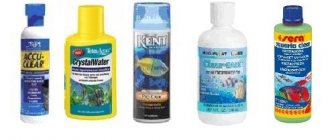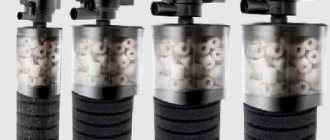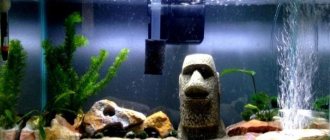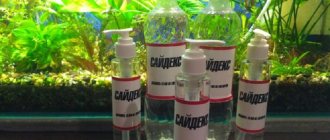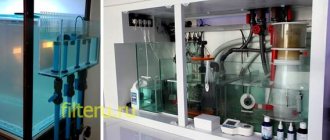Having seen the entire range of filter structures and various fillers for them in the store, you may get the impression that it is all very complicated and it is almost impossible to understand it. I hope that after this article you will not have any questions about filtration in an aquarium.
First, let's separate the concepts: a filter is an external (located outside the aquarium) or internal (inside the aquarium) structure for storing filter media. The filter pump pumps water through this filler, returning it back within a moment.
This is how the filtration system in the aquarium develops. Yes, there are many fillers and they are different, just like there are many different filter designs, but the basis is the same. Filter + filler. In reality, everything turns out to be quite simple.
Takashi Amano
Aquascaper
The filter in the aquarium is a ticking time bomb.
— Takashi Amano Aquascaper
The filter has four main functions: mechanical, biological and chemical filtration, as well as flow creation.
Let's look at the difference in design features.
Their cardinal difference is that the external filter is located outside the aquarium, and the internal filter is located inside. But both of them are a flask with a pump that drives aquarium water through it. The water passes through the flask with filler and is purified.
External filters are installed in the aquarium cabinet or next to the aquarium, but it is imperative that the upper part of the filter is 7 centimeters or more below the bottom of the aquarium.
This is necessary to ensure that the external filter pump operates without additional resistance and to increase the pressure from the filter.
- The greater the distance between the top of the filter and the bottom of the aquarium, the more efficient the external filter will work.
- And if, for example, you place an external filter next to an aquarium, then its efficiency will be minimal (the bottom of the filter is at the same level as the bottom of the aquarium). But now you know that it’s better not to do this, otherwise the filter will wear out.
For internal filters, a mandatory condition is that the pump must be immersed in water and not suck water from the surface of the aquarium.
Mistake #3. Intense lighting
Choose the right lighting mode and brightness!
An aquarium illuminated almost around the clock looks very beautiful, but this can lead to various unpleasant consequences. Depending on the fish and plants selected, the daylight hours in the aquarium should usually not exceed 10 hours. If it continues for too long, bacteria and algae will begin to actively develop.
You should also install the aquarium correctly. It should be in a place where direct sunlight does not fall on it, otherwise the walls of the vessel will become overgrown with algae.
If there are no live plants in your aquarium, reduce the duration of lighting to a minimum, since the fish do not particularly need it. To control the length of daylight hours, you can use a timer that will turn the lighting equipment on and off at a given time.
A short introduction
Hello dear readers of the Aqua-As website. Today in this review article I propose to talk about the JEBO 503 BF waterfall filter or as such filters of this type are also called (mounted or backpack filter). Looking ahead I will say. Yes, you understood absolutely correctly, a filter designed for an aquarium up to 100 liters is installed and works on an aquarium of 20 liters. And now in more detail.
Now we are launching a 20 liter aquarium for savage guppies and Fire Red shrimp, also known as red fire. By the way, the aquarium, as always, will not be entirely standard; I will definitely write about it in an article that is currently in the process of being created.
Mistake #4. Changing water
Change the water once a week!
To keep the inhabitants and vegetation in your aquarium healthy, it is necessary to carry out water changes correctly. It is absolutely not necessary to completely change all the water in the container. It is enough to replace a quarter or a third of the aquarium volume every week.
To do this, you can use cold tap water, which must be allowed to stand for at least a day. A good solution is to use water conditioners, which will make your tap water suitable for your aquarium. If there are no living plants in the vessel, you can clean the soil with a siphon at the same time as changing the water.
And remember!
No matter how good the filter is, changing the water still remains a prerequisite for caring for the aquarium! By doing this, you get rid of the waste products of living inhabitants, and also saturate the water with nutrients necessary for microorganisms and plants.
Mistake #5. Monitoring water parameters
Test your water parameters regularly!
As a rule, novice aquarists are not aware of such a phenomenon as the nitrogen cycle, and also do not know that it is extremely important to test the water parameters in the aquarium. Conducting such tests is necessary to monitor the level of toxins in the water.
After installing the aquarium, you need to let it stand for several days. Then start monitoring pH, hardness, nitrite and ammonia levels. Their level should be within normal limits.
In the beginning, it is necessary to test the water quite often for nitrites and ammonia. When the aquarium is already filled with vegetation and fauna, you should check the water once a month to avoid problems.
If your fish start to die, first check if the water parameters are normal.
Operating rules
Jebo aquariums are stocked with all types of fish, shellfish, shady vegetation and algae. The only condition is to determine the appropriate volume. After all, jebo tanks differ in volume.
The containers are suitable for sea and freshwater water with different levels of hardness and acidity. Before filling the water, the tank is washed. Running water is used for this.
Special requirements apply to the installation of tanks indoors.
- It is prohibited to install containers near heating equipment or heating elements.
- There are no acoustic systems or electronic equipment located near the tank. After all, radiation and noise affect the development of fish and plants.
- The jebo aquarium is located away from the windows. After all, direct rays should not fall on the structure and its inhabitants.
- The container and filter elements are washed under running water before use.
- The release of shellfish and fish is carried out after 2–4 days. This time is enough for beneficial bacteria to appear in the water. The tanks are filled with algae and vegetation.
- The containers are periodically inspected in order to detect leaks in a timely manner.
The jebo aquarium is a container that deserves special attention. After all, it has unique characteristics. Among the tanks supplied by the Chinese company, it is easy to choose a model that has the required volume and configuration.
Mistake #6. Selecting and maintaining an aquarium filter
Choose a filter of suitable volume!
To keep the water in the aquarium clean, you need to choose a filtration system that will circulate all the water through it at least 3 times within an hour. If you are in doubt about which filter to install, take the equipment one size larger: you will definitely not overfilter the water, but you are guaranteed to avoid the problem of water contamination.
Do not forget about timely cleaning of the filter!
Regardless of the type of filter system you use (internal or external canister filter), it is important to maintain it properly.
Remember!
Under no circumstances should the filter material be washed with tap water. To do this, you must use exclusively aquarium water. Otherwise, you will destroy the microorganisms living in the filter, whose task is to purify the water.
Don't be intimidated by "dirty" filter sponges. There is no need to clean the filter too often. Be guided by the flow of water through it and its transparency.
Types of filter media
- Mechanical
- biological
- chemical
Mechanical filtration
Consists of spongy materials. This includes, as the porosity of the material increases: synthetic winterizer, fine-pored sponge, large-pored sponge.
Sintepon is a finely porous material that traps the smallest particles from aquarium water.
It is usually used only in certain cases: a suspension has formed, the water has turned green, something cloudy has been added to the aquarium, the soil has been replaced - in general, padding polyester is used after some work has been done in the aquarium.
In addition, it happens that there are fish in the aquarium that constantly raise turbidity and this creates visual untidiness in the aquarium, and also impairs the penetration of light into the water column.
- In such cases, you can keep the padding polyester in the filter on a permanent basis, but it must be washed weekly so that the filter’s water flow does not weaken.
- The padding polyester material is short-lived, it can last for 2-3 washing cycles, and then you need to use a new one.
Sold in several formats: round or square plates for a specific filter model or large layers from which you need to cut a plate for your filter model.
New filter models are often made in such a way that the padding polyester cannot be cut from the plate and can only be purchased in branded packaging. By the way, you can also pay attention to this nuance when purchasing an external filter - operating costs.
Fine-porous and large-porous sponges are a durable material for filtering water from large and small particles (for the smallest - dusty ones, it is not suitable, you need synthetic padding). It is used to purify water from mechanical suspension in an aquarium.
Sold in layers or also for a specific filter model. For modern filters, manufacturing companies make their sponges in such a way that it is almost impossible to cut them out of the layer, so you will have to buy factory ones.
Sponges of different porosities can be used simultaneously in one filter.
Sintepon, large and small sponges CAN be washed with tap water, but only if, in addition to mechanical filtration, you also have biological filtration. If there is no biological filtration (which is wrong in principle, but is extremely common), then only 30% of the mechanical filter filler can be washed with tap water. The rest is water from the aquarium.
Note: if you rinse the sponges in a bucket with aquarium water, this water can then be used in the garden to water the plants, they will thank you for their beautiful flowers.
Ceramic rings/balls are a filler used only in external filters to break up the inlet flow into the filter.
From the aquarium, water enters the filter with a powerful turbulent jet, which must be broken into a laminar, uniform and at the same time weaker flow so that the biological filler of the filter is washed evenly by the aquarium water.
For these purposes, ceramic balls are used, which are placed at the very bottom of the external filter. They can be washed with tap water.
Some ceramic balls are made porous so that they combine both mechanical and biological filtration. It is better to wash such balls with aquarium water.
Biological filtration
A filler in which special bacteria populate. They process waste from fish and bacteria at the biological level.
During the life of an aquarium, toxic substances are released into the water: ammonium/ammonia and nitrites. The biological filter processes these toxic substances, making them harmless to the inhabitants of the aquarium.
In aquascaping, biological filtration is not always given due attention, thinking that there is enough soil and plants (they are also biological filters), but the more your planted aquarium is accelerated (more fertilizers, CO2 and light), the higher the likelihood that when it occurs in the water ammonium or nitrites, algae will appear - the most terrible enemy of any aquarium with plants.
Highly porous fillers are used as a biological filter, the main characteristic of which is the total surface area for colonization by bacteria. This is usually indicated on the manufacturer's label. The most common biological fillers:
Eheim substrate pro
Sera Seporax
Chemical water filtration
In addition to sponges and biological balls/rings, chemically active sorbents (absorbers) can also be placed in the filter.
This may include:
- Activated carbon;
- absorbers of nitrates, phosphates, silicates, ammonium, nitrites;
- fillers to increase/decrease dKh, dGh, pH.
Chemical fillers differ in that they are installed temporarily. After reaching their potential, they are removed from the filter and replaced with new or other fillers (biological or mechanical).
Activated carbon is used when it is necessary to reduce the concentration of carbon dioxide (increase pH), remove excess organic compounds dissolved in water, and remove yellowness of water.
In planted aquariums, activated carbon is always used during the first month of starting a new aquarium. During this period, 80% of the capacity of the external filter flask is allocated to activated carbon.
With fillers that change the pH, you need to be very careful and first of all you need to figure out why at a given time in the aquarium the pH is at a value different from what we need.
Fillers for changing dKh and dGh in planted aquariums are rarely used.
Only when using pure osmosis to slightly increase the water hardness, but usually salt remineralizers are used for such purposes.
The remaining chemical fillers are used if necessary, judging by water tests.
Let's look at the arrangement of fillers in an external filter in an aquarium that is already in operation (from the bottom up or along the direction of the water flow):
- ceramic rings for breaking the flow in the aquarium;
- biological filler
- 1 coarse sponge
- 1 fine sponge
If the internal filter turns off for a long time and does not turn on itself: remove the filter from the water as carefully as possible. The less dirt from it gets back into the water, the better. You can try wrapping it inside the aquarium in a bag and taking it out along with the bag. Rinse the filter media thoroughly with aquarium water. Install it back and plug it into the network.
Install additional aeration. If this is not possible, then direct the flow from the filter towards the water surface.
If it is impossible to do this, install an internal filter at the height of the aquarium wall so that the flow of water from the filter breaks the surface of the water, but the pump does not suck air from the surface.
When disconnecting the external filter for a long time, the procedure is the same: open the filter, rinse the filler with aquarium water, plug the filter back into the outlet, and create additional saturation of the aquarium with air.
Regardless of the type of filter used, once it is put into operation after cleaning, it is necessary to add nitrifying bacteria, for example:
Prodibio Start Up
Bioptim
Nitrivec
Mistake #7. Operation of aquarium equipment
Do not turn off aquarium equipment at night!
Imagine that you live in hot Africa, and when you go to bed, you not only turn off the lights in the house, but also turn off the air conditioner, while closing all the windows tightly. If you are a thrill-seeker, then, of course, you can experiment on yourself, but it’s better not to do this with fish!
Remember!
The compressor and pump filters must not be turned off overnight. If you don't like the constant hum of the compressor, you can try installing an internal filter in your aquarium. If a compressor can make distracting and irritating sounds during operation (by the way, high-quality products from well-known manufacturers will delight you with their relatively quiet operation), then modern pump filters are almost silent.
You just need to turn off the function responsible for pumping air bubbles out of the outlet (which is provided in almost every model) and direct the water jet to the surface. Then there will be no need for a compressor, since the water will be well saturated with oxygen due to diffusion with air and the resulting flow.
But if there are quite a lot of fish in the aquarium, and the size of your artificial pond is small, you will still have to install a compressor. Therefore, think in advance where the aquarium will be located, and if you think that the most suitable place for it is the bedroom, think carefully about what equipment will suit you in this case.
Characteristic features of the jebo aquarium
The jebo aquarium was created by the company of the same name, which has been producing aquarium equipment for a long time. When the model first arrived in stores, the tank caused surprise and delight among aquarists - the jebo is made without seams, which allows you to view the underwater depths and inhabitants from all angles. Thanks to the hard work of the designers, the side walls of the tank gradually merge into the front part, which classifies the jebo as a seamless aquarium. This property is considered the “highlight” of the model.
Another characteristic feature of the model is the functionality of the jebo. The aquarium is equipped with built-in equipment: a filter, pump, aerator and light bulbs are located in the tank lid. Thus, the company took care of the convenience of the owners: the equipment is started when one contact is plugged into the socket - and the devices work. Also in stores are models without built-in equipment.
Why is it necessary and what should be the correct flow in an aquarium?
The movement of liquid in a tank performs a number of important functions:
- By mixing water from different layers, the overall temperature in the aquarium is equalized.
However, in each specific case, you need to proceed from the type, size and characteristics of your tank and, most importantly, from the needs of its inhabitants (not only fish, but also plants). For example, there are breeds of fish that live in fast-flowing waters (iris, labeo, some cichlids, etc.).
For them, the active movement of liquid in the aquarium will be of critical importance. But for fish that naturally live in stagnant waters (for example, labyrinth fish), a strong current will be harmful and even dangerous.
Therefore, when selecting neighbors in a common aquarium, you must take into account the natural needs of your pets and place together only those species for which the conditions of detention are similar.
Negative effects of too much flow in an aquarium:
- Increased growth of “blackbeard” - red algae of the genus Compsopogon (occurs due to excessive aeration and high content of organic substances).
Advantages and disadvantages
Like any model of artificial reservoirs for fish, the jebo aquarium has a number of advantages and disadvantages. The advantages of seamless tanks include:
- A simple design that is easy to move and install.
- Functionality - the models are equipped with aquarium equipment that is necessary to support the life of pets and plants.
- Cost – seamless aquariums are cheaper than Italian and German models.
- Wide assortment - among the containers, every aquarist will be able to choose a tank to his liking.
- Equipment - the container is equipped with a lid, a stand, and some kits include additional elements and filters.
Despite their significant and attractive advantages, jebos also have disadvantages that owners identified when using seamless tanks:
- The appearance of microcracks - for the manufacture of jebo, seamless glass made of silicate or acrylic is used, so cleaning the container is carried out with care, using specially selected tools.
- Insufficient light bulb power – some aquarists note that the bulbs built into the lid do not provide enough light. This drawback is eliminated by purchasing additional lighting.
- Noise – the pumps included in the kit make a lot of noise when operating, which frightens some species of fish.
- The seams are processed regularly, since the hoses are connected poorly.
The jebo aquarium has caused a lot of controversy in aquarium circles, despite its appearance and modern design. But, even taking into account the shortcomings of the tank, it is worth noting that jebos have been successfully used for keeping fish for a long time, and among the company’s assortment, every aquarist will choose a model to his liking.
How to create an artificial current
If you decide that your tank needs flow, there are several ways to organize it.
- Installation of a compressor to organize an “air wall”. This method is perfect for small tanks with a volume of up to 20 liters. With this method, the protein film is effectively removed, and active gas exchange with the air occurs.
- Installing a filter that will “drive” water. In this case, the formation of flow is a bonus from the operation of the purifier.
This method often cannot provide the required water flow in large tanks.
- Installation of a special pump. This device is directly designed to create a flow in the aquarium, mix different layers of water, and if you use a foam tube together with a pump, then this device will also replace a mechanical cleaner. This method will be effective for large aquariums. You need to choose a pump based on its size, the type of fish and plants, and the performance of the device (measured in l/hour). Many modern pumps have power regulators, which make it very convenient to control the flow rate.
If the water flow in the aquarium is quite strong, you need to design the tank according to certain rules:
- It is better to choose coarse rocky soil.
- Plants must have a strong root system and tolerate strong flows well. You can also choose mosses that grow on driftwood.
- All underwater decor must be securely fixed in the substrate.
Appearance of JEBO 503 BF and minor modernization
Waterfall filter JEBO 503 BF
Since the filter came from a completely unfamiliar aquarium, I tore off the padding from the cartridge and removed the carbon accordingly. In place of the original sponge (dark color in the photo), I used a scalpel to cut out a suitable new sponge (blue color in the photo). According to the idea, there will be a sponge that will retain large particles of debris, plus the biofiltration process will take place on it, and in the second compartment there will be a porous filler for purely biofiltration. The filler has also already been ordered and is on its way from China. Once the package arrives, I’ll unpack it and write a review.
Appearance of JEBO 503 BF
On the left is a new sponge on the right is original
How to reduce filter flow in an aquarium
The water flow from the filter should be reduced in the following cases:
- In a herbal aquarium, there is a strong disturbance of the vegetation, the plants lean to one side and to the bottom or are completely torn out of the ground.
- The fish is limply carried aside by the water. They swim, strongly resisting the flow, or do not move at all and sit in places with the weakest water flow (“dead zones”), but such low activity is unusual for the species.
- The soil is being washed away.
- The growth of red algae has increased.
Video: how to reduce flow in an aquarium One of the most common, effective and affordable ways to reduce flow is to install a flute on the filter. A flute, or sprinkler, is a device in the form of a perforated hose or tube that fits onto the spout of the filter and disperses water through numerous holes, weakening the flow force in the tank.
Many aquarists prefer to make a flute from improvised or easily accessible materials: small-diameter PVC tubes (10–12 mm), an adapter for a filter (you can use a silicone flange) and suction cups for attaching to the walls of the tank.
The required number of holes is drilled on the tube over the entire surface, one end of the tube is attached to the filter using an adapter, the other end must be closed with a plug (it is not recommended to solder it, since the tube will need to be washed periodically).
If necessary, the tube can be bent to give it the desired shape by gradually heating it with a hairdryer.
Other ways to reduce flow:
- If your filter model is equipped with a power regulator, you can simply try to reduce it.
- You can rotate the filter tube so that the stream of water breaks on the glass of the aquarium.
- Plug the filter outlet with a fine-pored sponge. According to aquarists, the sponge does not clog even over time, but effectively reduces the flow power.
